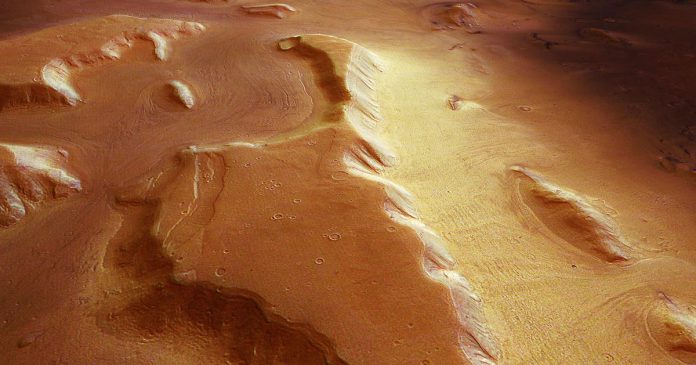When the topic of ice on Mars comes up, the first thing that usually comes to mind are the polar ice caps which are prominent even in small telescopes. There is, however, ice elsewhere on the planet as well, such as beneath the surface in the mid-latitudes, covered by dust. Now, a new study has revealed the extent of these subsurface glaciers and the amount of frozen water they contain.
As it turns out, there is a massive amount of water ice just below the Martian surface, hidden by a thick layer of dust. The new study calculates that there is enough ice to cover the entire surface of Mars with 3 feet (1.1 meters) of ice. As Nanna Bjørnholt Karlsson, a postdoc at the Centre for Ice and Climate at the Niels Bohr Institute at the University of Copenhagen, explained:
“We have calculated that the ice in the glaciers is equivalent to over 150 billion cubic meters of ice – that much ice could cover the entire surface of Mars with 1.1 meters of ice. The ice at the mid-latitudes is therefore an important part of Mars’ water reservoir.”
The new results were obtained by a group of researchers at the Niels Bohr Institute, who made the calculations using radar observations from the Shallow Subsurface Radar (SHARAD) instrument on Mars Reconnaissance Orbiter (MRO), combined with ice flow modeling.
“We have looked at radar measurements spanning ten years back in time to see how thick the ice is and how it behaves. A glacier is after all a big chunk of ice and it flows and gets a form that tells us something about how soft it is. We then compared this with how glaciers on Earth behave and from that we have been able to make models for the ice flow,” explained Karlsson.
From some locations there is detailed high-resolution data, but only more sparse data from other areas. By supplementing the sparse data with information about the flow and form of the glaciers from the well-studied areas, the research team has been able to calculate how thick and voluminous the ice is across the glacier belts.
The SHARAD team is also confident that the features are actually buried glaciers. As Jeff Plaut, SHARAD Science Team Member, told AmericaSpace:
“The consensus of the MRO SHARAD team is that these features are indeed glaciers, as was reported when first probed by the radar.”
Previously, scientists weren’t sure if the buried ice was composed of water, frozen carbon dioxide, or mud. Now it is known to be water ice, and it also resembles glaciers on Earth. Many such glacier-like features have been seen on the Martian surface, with over 10,000 found so far. They were first noticed in images taken by the Viking orbiters in the 1970s. The subsurface glaciers are in belts circling the planet between 300-500 degrees latitude, in both the northern and southern hemispheres. In the northern hemisphere, that would be equivalent to just south of Denmark on Earth.
There is also the question of why they are located where they are.
“An obvious question would be, why they have a specific distribution on the planet? Why are they not everywhere?” Karlsson said, adding that some previous studies have suggested the glaciers migrated from the poles. “We only see them within certain latitudes.”
“The ice at the mid-latitudes is an important part of Mars’ water reservoir,” Karlsson added.
It is thought that the glaciers are likely the remnants of a previous, much larger ice sheet. The thick layer of dust helps to protect the ice from evaporating into the thin Martian atmosphere as it normally would do, since even ice exposed to the hyper-thin atmosphere and low pressure doesn’t last long.
“The atmospheric pressure on Mars is so low that water ice simply evaporates and becomes water vapor,” the institute said in a news release.
The findings are also interesting in terms of another Martian phenomenon, the famous Recurring Slope Lineae (RSL)—narrow dark streaks on steep equator-facing slopes which many scientists now think may be caused by small amounts of briny water running down the slopes. They grow during warmer seasons and fade during colder seasons. Could melting subsurface glacier ice be the source of these enigmatic features? We don’t know yet, but the possibility is an interesting one. Various studies have shown how salts, known to be common on Mars, could allow water to remain liquid on the surface for brief periods of time.
The SHARAD team, however, thinks that the glaciers are unlikely to be related to RSLs. As Plaut told AmericaSpace:
“We do not believe these features are currently associated with liquid water, and probably were ‘cold-based’ throughout their history. The ice seems to be protected by layers of soil and rock up to 10 meters thick. This makes it unlikely that there is a relationship to the RSLs, which seem to be much shallower features.”
There is also the age-old question of where most of Mars’ water has gone, since it is now accepted among scientists that there used to be a lot of it on the surface, before the planet became the much colder, drier place we see today. Much of the water has been slowly lost to space, as spacecraft like MAVEN have shown, but a lot of it also seems to have simply frozen and become buried under thick blankets of dust.
Some ice is much closer to the surface; the Mars Phoenix Lander was able to scoop just a few inches into the soil near the Martian north pole and found water ice in abundance, very similar to permafrost on Earth. Now we know there is much more ice a bit deeper down, and perhaps even liquid water in places below that, which would be an even more exciting discovery.
The glaciers are another reminder of how similar Mars used to be to Earth in many ways, and even still is.















